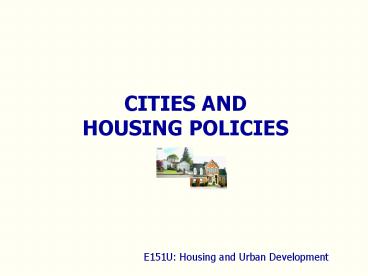CITIES AND HOUSING POLICIES - PowerPoint PPT Presentation
1 / 17
Title:
CITIES AND HOUSING POLICIES
Description:
Theory predicts cities will spend more on economic development than affordable ... Cities spending higher levels of federal funding for housing, cities that had ... – PowerPoint PPT presentation
Number of Views:37
Avg rating:3.0/5.0
Title: CITIES AND HOUSING POLICIES
1
CITIES AND HOUSING POLICIES
E151U Housing and Urban Development
2
TheoryThe City Limits Explanation
- Begins with a regional market of public goods
(cities) similar to the market for private goods
3
Regional Market of Cities
4
Key Players in the Market
- Residents choose to live in communities that
maximize their preferences for local services
(Tiebout, 1956) - Local decision makers
- seek to retain/attract middle- and upper-income
residents - consider the impacts of their taxing and spending
decisions and seek to offer the best cost to
benefit ratio (tax to service) - compete with other cities by formulating policy
to their city's economic advantage and - avoid redistributive policy such as affordable
housing and pursue developmental policy such as
economic development (Peterson 1981 Downs,
1994)
5
Empirical StudyTest the theory
- Theory predicts cities will spend more on
economic development than affordable housing, and
that this propensity will increase as competition
increases in the region
for affordable housing
Competition
6
Empirical Study
- Survey Data gathered through a mail survey of
city policymakers and staff - The cities were in all areas of the country
- Census Data collected U.S. Census data from 1990
- Additional sources from publications
7
Dependent Variable
Distribution Non zero values logged (n396)
Source Basolo, Victoria. 1999. The Impacts of
Inter-city Competition and Intergovernmental
Factors on Local Affordable Housing Programs.
Housing Policy Debate 10(3)659-688.
8
Study Variables
- Dependent
- Local Housing Support
- Dichotomous 1 expended
- 0 did not expend
- Continuous expended, if any
- Independent
- Inter-city competition of cities in
region (MSA) - Other independent variables presence of
planning, federal funding, growth rate, etc.
9
Study Findings
- Cities in regions with higher levels of
inter-city competition were less likely to spend
any of their own source dollars on affordable
housing compared to cities in areas with lower
levels of competition - Cities with entitlement status for federal block
grant programs and cities with higher growth
rates were less likely to spend their own source
dollars on housing programs - Cities spending higher levels of federal funding
for housing, cities that had higher levels of non
profit housing activity, cities with higher
housing values, and larger cities were more
likely to spend their own source dollars on
affordable housing activities (Basolo, 1999)
10
Study Findings
- The degree of inter-city competition appeared to
have no effect on the level of own source
expenditures on affordable housing in cities - As the homeownership rate increased in cities,
own source expenditures on affordable housing
decreased - Having an official housing plan, state-mandated
housing set-asides, and population size were
positively related to own source expenditures on
affordable housing programs (Basolo 1999)
11
More Study Findings
- Cities in regions with higher levels ofinter-city
competition were more likely to spend own source
dollars on economic development efforts1 - Cities with a formal economic development plan
were more likely to spend own source dollars on
economic development - Cities with higher levels of support for economic
development from elected officials were more
likely to spend their own dollars on these
efforts - Cities in regions with higher levels of
competition were more likely to spend more of
their own dollars on economic development than
affordable housing activities.2
- ________________________________
- Basolo, V. and C. Huang. 2001. Cities and
Economic Development Does the City Limits Story
Still Apply? Economic Development Quarterly
15(4)327-339. - Basolo, V. 2000. City Spending on Economic
Development Versus Affordable Housing Does
Inter-City Competition or Local Politics Drive
Decisions? Journal of Urban Affairs 22(3)317-332.
12
Is Affordable Homeownership a Special Case?
Our first goal is to increase citywide
homeownership from the current average of 40 to
75. Why is this important? Because
homeownership creates pride and security and
because homeownership builds our population base
which in turns builds our tax base.
--Mayor R. Filippi (2003)
13
What did Mayors Think About Homeownership in
Their Cities?
Importance of increasing homeownership to their
citys fiscal health
14
What Type of Policy isAffordable Homeownership?
Intercity Competition
Support for Homeownership
Does this relationship hold? If yes, then Does
inter-city competition result in lower support
for homeownership? If yes, then this result
suggests homeownership policy is redistributive.
Does inter-city competition result in higher
support for homeownership? If yes, then this
result suggests homeownership policy is
developmental.
15
Results of Analysis
- There is a positive relationship between
inter-city competition and support for
homeownership
In other words.
Higher levels of regional competition are
associated with cities that spent more on
homeownership programs versus other types of
housing programs
Affordable homeownership is viewed as
developmental policy, therefore, is more likely
to be supported by local policymakers
16
What are the Implications of These Findings?
- About local policy?
- About devolution?
- About the distribution of cities in a region?
17
Orange County, CA
Source U.S. Census Bureau.
N





![❤[PDF]⚡ New Deal Ruins: Race, Economic Justice, and Public Housing Policy PowerPoint PPT Presentation](https://s3.amazonaws.com/images.powershow.com/10047352.th0.jpg?_=20240604104)

























